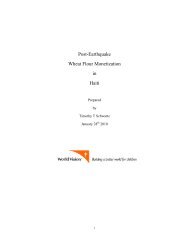CNSA Targeting
Create successful ePaper yourself
Turn your PDF publications into a flip-book with our unique Google optimized e-Paper software.
23<br />
3. Beneficiary Detection Strategies in Haiti<br />
This section examines in the context of Haiti each phase of Beneficiary Detection Strategy<br />
introduced above. Specifically, geographic criteria, beneficiary unit, beneficiary criteria, and<br />
beneficiary selection. It evaluates the utility of each as we found them being applied Haiti, both<br />
through reading reports and interviewing aid workers and beneficiaries in the field.<br />
Geographic Criteria in Haiti<br />
It is always very difficult to quantify malnutrition in Haiti. …the data available from actors<br />
appears to show that, strictly speaking, there are no pockets of malnutrition.<br />
ECHO 2011:24<br />
Although partners in the World Bank and USAID sponsors programs Kore Lavi and Kore Fanmi<br />
have targeted specific departments and communes based on <strong>CNSA</strong> vulnerability assessments (see<br />
CARE 2013a), a longitudinal look at survey data suggest that, with the exception of the Port-au-<br />
Prince metropolitan area and the Department of the West in which it is located, there is little<br />
evidence to justify more than moderate application of geographical criteria in Haiti. Not if the<br />
objective is to aid the most vulnerable.<br />
Based on the 2001 HLCS, most departments have essentially equal populations of “extremely<br />
poor” people (individuals living on less than US$1 per day), varying between 62 and 72 percent<br />
(Figure 12). The only exception was the North East, with 84 percent of its population extremely<br />
poor; arguably no exception at all because 67% of the country’s rural population at the time was<br />
extremely poor and the North East was, at that time, the least urbanized Department in Haiti. In<br />
other words, the proportion of the population that is extremely poor is essentially the same in all<br />
of Haiti’s 10 Departments.<br />
Using the Genie coefficient based on durable goods (assets) as an estimation of wealth distribution<br />
(a value of 01 indicates egalitarian distribution and 100 total inequality), all the departments rate<br />
in the narrow range between 37 to 43 points (see Figure 13; based on the 2012 EMMUS sample<br />
of 13,388 households) In other words, the level of equality in distribution of wealth is essentially<br />
the same throughout the country’s 10 Departments. viii<br />
The same is true for variation among Departments regarding months of nutritional stress (Figure<br />
14). Even variation among ecological zones yield small differences (Figure 15). <strong>CNSA</strong> found that<br />
from October 2006 to September 2007 the population of households reporting insufficient<br />
alimentation in six ecological-occupational zones fluctuated between highs of 52% and 64% for<br />
each zone to lows of 15 to 36 percent; all tended to have the same lean months and the same<br />
months of plenty with the one notable exception that agricultural mountain humid, agro-pastoral<br />
semi-humid, and agro-pastoral plateau tended to have lower stress during the Autumn months than<br />
agro-pastoral dry, mono-cultural plain, and dry agricultural and fishing. WFP’s Coping Strategy<br />
Index (CSI), a 0 to 64 point measure of food deprivation and rationing varies between 20.8 for<br />
coastal dry and 24 for Agro-Pastoral Dry, a fluctuation small enough to be attributed to natural<br />
sampling error (Figure 16: Wiesmann et al. 2009 for an explanation of CSI). The same equality
















